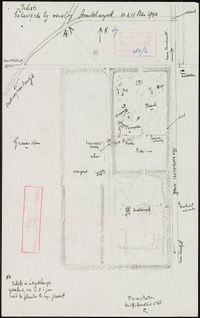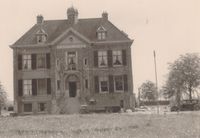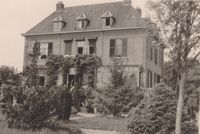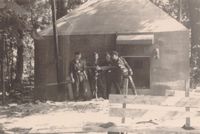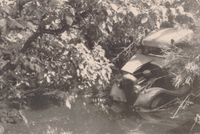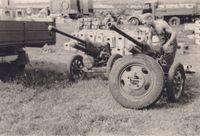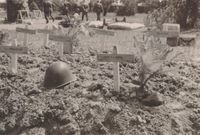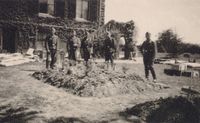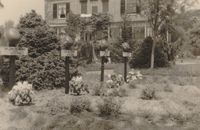The villa park Amstelwijck May 1940.
During the mobilization period and the events in May 1940, the villa park Amstelck served as the headquarters of the 1st battalion of the 28th Infantry Regiment (I-28 R.I.). The headquarters was located in the villa. Major van Hoek was the commander of the Wieldrecht sector, which was overseen from Amstelwijck. The headquarters was connected to Group Kil in Puttershoek via a PTT cable and underwater line. In the adjacent villa park, four type P bunkers were built for the headquarters. The villa park was surrounded by ditches and accessible via two bridges. One of the bridges was located approximately to the southwest of the villa park, while the other was a stone bridge in the south between the villa park and the villa.
On May 10, 1940, German paratroopers landed south of Amstelwijck in the fields near Rustenburg and along the Wieldrechtse Zeedijk. These German paratroopers from Fallschirmjäger Regiment 1 quickly attacked the positions of the Dutch artillery units of I-17 R.A. and III-14 R.A. in this area. Meanwhile, the 3rd company of Fallschirmjäger Regiment 1 also landed in the meadows in the Krispijn district. This company was neutralized by the Railway Troops and Depot Troops of the Army Maritime Engineers Corps. As a result, the 2nd and 4th companies (2./FJR 1 and 4./FJR 1) of Fallschirmjäger Regiment 1 were directed towards the bridges over the Oude Maas, which were occupied by a platoon of the 3rd company that had landed in Zwijndrecht. On their way, the 2nd and 4th companies passed by Amstelwijck, where a battle ensued between Dutch military forces and the German paratroopers.
At the time of the German attack, there were 82 officers and enlisted men from I-28 R.I. at the command post. This number would grow to about 100 as additional personnel from the artillery at Gravensteijn fled to Amstelwijck. The defense of the bunker park and the villa was poorly organized. Major van Hoek was preoccupied with telephone calls and rarely left his bunker. Meanwhile, the 4th company of Fallschirmjäger Regiment 1 moved along the Nieuwe Rijksweg towards Amstelwijck, while the 2nd company moved in that direction along the old Rijksstraatweg. The 4th company encountered heavy machine gun fire from the heavy machine gun positioned at the most northeastern of the four bunkers in Amstelwijck park. The 2nd company also faced fire from the bunker park as it regrouped north of Gravesteijn. The 2nd platoon under Lieutenant Graf von Blücher was ordered to Sketch by the medical officer of health 2nd class
engage this resistance. P.W. van Hattum.
While the Dutch were unaware of the impending danger, Lieutenant Graf von Blücher and a group of men moved across the Koekebakkerskil and past the stables. He formed a shock group consisting of himself and five others and charged over the southwestern bridge. Amid loud screams and grenade throwing, the many Dutch soldiers in the bunker park were completely taken by surprise. It was easy shooting for the German paratroopers, and the grenades were also effective. Two paratroopers stayed behind to provide covering fire while the Lieutenant and the other three advanced and threw grenades into two of the bunkers. During this action, the Lieutenant sustained a graze wound, and Feldwebel Müller was severely injured. The approximately 75 Dutch soldiers in the bunker park were completely overwhelmed. Major van Hoek was rendered unconscious in his bunker by a grenade. As the fighting ceased in the villa park, he (according to his own combat report) had a submachine gun pointed at his back, and he was forced to order the surrender of the occupants in the villa.
On the Dutch side, there were 12 fatalities and approximately 25 wounded to mourn., the remainder ( 50-60 men) were taken prisoner and transported to the barracks camp near the "Tweede Tol". The Germans lost four men from the 4th company of Fallschirmjäger Regiment 1 and had seven wounded. The wounded were cared for in the villa park. The Dutch casualties were buried next to the villa on the western side, while German casualties were buried on the southern side.
In the evening, the Germans evacuated the villa and the park. It was recaptured by Dutch troops who found it abandoned. The photos below were taken around May 16, 1940, by Luftwaffe soldiers. It is unclear whether if these are paratroopers. *1
The above photos are beautiful shots of Villa Amstelwijck. The first photo is a lovely shot of the front of the villa, taken with the back facing the villa park where the casemates are located. In the top left corner, a windowpane is broken due to the fighting. There are also bullet impacts visible on the roof tiles. The other two photos were taken from the back of the villa. With the back facing the German field graves that were situated in the garden. In the second photo, the bullet holes on the roof of the villa are clearly visible.
The above photos provide some interesting perspectives of the terrain at Amstelwijck in May 1940. The first photo was taken at the casemate where Medical Officer P.W. van Hattum had set up a first aid station. There are German soldiers at the casemate, one of whom is holding a Dutch Hembrug carbine. On the bench in front of the casemate, a Dutch field cap is on the left, and a Dutch sewing kit is on the right. In the next photo, two German soldiers are posing by the destroyed car. The story behind this car is unclear, but the vehicle can be seen in several photos taken at Amstelwijck. If you look closely, to the right of the car you can see the footbridge that was located southwest of the villa park. A portion of the concrete wall is also clearly visible. The subsequent photo raises many questions. It shows a Dutch truck that has ended up in the ditch, presumably near Amstelwijck. Medical Officer P.W. van Hattum mentions the following in his combat report:
"While I was there, I saw a delivery van approaching at high speed from the direction of the Moerdijk bridges. At the height of Amstelwijck, it was hailed and shot at. However, I saw a soldier dressed in an unfamiliar uniform jump out of the van, who quickly disappeared behind the roadside on the other side of the highway.
Upon our calls in Dutch and German to come out, nothing happened However, when a grenade was retrieved from Astelwijck and exploded on the other side of the road, we saw a white cloth emerge above the embankment. Subsequently, the German paratrooper crossed the road, was helped over the ditch by us, disarmed, and then taken to Major van Hoek, who was at his command post in the forest near the casemates at that time."
This might be the delivery van that Medical Officer van Hattum mentioned in his report. Next photo shows a German soldier by Dutch anti-tank guns. Behind him are many ammunition crates and other equipment. It's uncertain to say if the photo was taken at Amstelwijck. In the background of the photo, there is a dike. Therefore, the photo could have been taken at Tweede Tol as well.
Above you can see these remarkable photos of the Dutch field graves at Amstelwijck. The field graves were located next to the villa on the west side of the villa. German soldiers are posing at the field graves that have only been there for a few days. In the background of the garden, there is still various equipment. If you look closely, on the first photo, you can see German field graves at the back of the garden. The graves in the photo are of the following Dutch soldiers (all killed on May 10, 1940) *2 :
- Conscript Corporal Franciscus Jozef van Breukelen (Staff-I-28 Regiment.Infantry.).
- Conscript Sergeant Petrus de Haan (Machine gun Company-I-28 Regiment.Infantry.).
- Conscript Soldier Theodoricus Antonius Beekman (Machine gun Company-I-28 Regiment.Infantry.).
- Conscript Soldier Jacob van Duin (Staff-I-28 Regiment.Infantry.).
- Conscript Soldier Rubertus Rietveld (Machine gun Company-I-28 Regiment.Infantry.).
- Conscript Corporal Petrus Johannes van den Bos (Machine gun Company-I-28 Regiment.Infantry.).
- Not readable.
- Volunteer Soldier Pieter Hendrik Bloem (Staff-I-17 Regiment.Artillery.).
The above photos were taken in the garden of Villa Amstelwijck in May 1940. Here we see the paratrooper field graves of four German casualties from 11./FJR 1. These paratroopers were killed in combat with Dutch Hussars from the 2nd Motorized Hussar Regiment (2 R.H.M.) near the viaduct at the Zeehaven. These German paratroopers all perished on May 12, 1940. They are not the four casualties from 4./FJR 1 from May 10th as previously assumed. The fallen are: *3 *4 :
- Gefreiter Johannes Graband ( 11./FJR 1 ).
- Obergefreiter Josef Tillmann ( 11./FJR 1 ).
- Gefreiter Johannes Barty ( 11./FJR 1 ).
- Gefreiter Leonard Kramer ( 11./FJR 1 ).
©2017-2024 :Https://www.Dordrechtindeoorlog.nl: ( There is a copyright on the content of this website. This content is not to be shared, duplicated or published withouth the explicit permission of the author of this website. If you have any requests you can email to: Info@Dordrechtindeoorlog.nl or look on : www.dordrechtindeoorlog.nl/termsofuseforthecontentonthiswebsite.
Sources: Zuidfront-Holland1940 en Dordt Open stad.
*1 Source: www.Zuidfront-Holland1940/10 mei 1940 - Wielwijk 1e fase.
*2 Source: www.Zuidfront-Holland1940/Nederlandse gesneuvelden.
*3 Source: www.Zuidfront-Holland1940/Duitse gesneuvelden.
